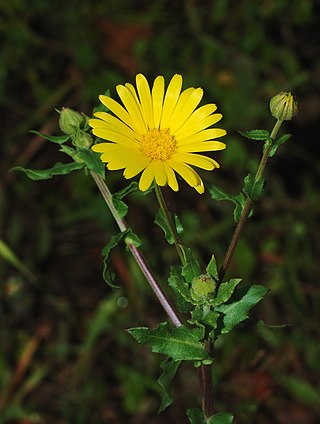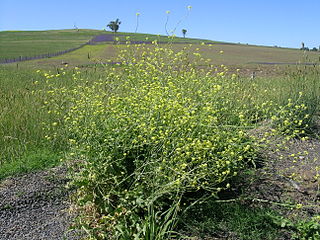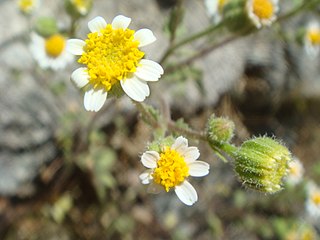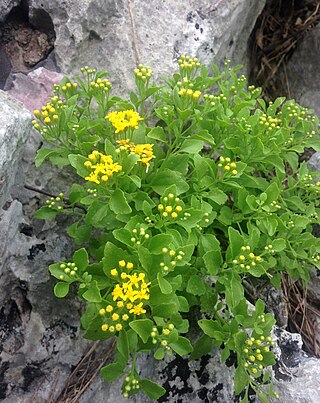
Calendula is a genus of about 15–20 species of annual and perennial herbaceous plants in the daisy family, Asteraceae that are often known as marigolds. They are native to southwestern Asia, western Europe, Macaronesia, and the Mediterranean. Other plants known as marigolds include corn marigold, desert marigold, marsh marigold, and plants of the genus Tagetes.

The Inyo Mountains are a short mountain range east of the Sierra Nevada in eastern California in the United States. The range separates the Owens Valley to the west from Saline Valley to the east, extending for approximately 70 miles (110 km) south-southeast from the southern end of the White Mountains, from which they are separated by Westgard Pass, to the east of Owens Lake.

Alnus incana, the grey alder, tag alder or speckled alder, is a species of multi-stemmed, shrubby tree in the birch family, with a wide range across the cooler parts of the Northern Hemisphere. Tolerant of wetter soils, it can slowly spread with runners and is a common sight in swamps and wetlands. It is easily distinguished by its small cones, speckled bark and broad leaves.

Banksia incana, commonly known as the hoary banksia, is a species of shrub that is endemic to the south-west of Western Australia. It has hairy stems, narrow linear leaves, heads of bright yellow flowers and later, up to thirty-six follicles covered with greyish hairs in each head.
Sphaeralcea incana, with the common names gray globemallow and soft globemallow, is a desert plant in the mallow family (Malvaceae).

Matthiola incana is a species of flowering plant in the cabbage family Brassicaceae. Common names include Brompton stock, common stock, hoary stock, ten-week stock, and gilly-flower. The common name stock usually refers to this species, though it may also be applied to the whole genus Matthiola. The common name "night-scented stock" or "evening-scented stock" is applied to Matthiola longipetala.

Perityle is a genus of flowering plants in the daisy family. They are known generally as rock daisies.

Hirschfeldia incana is a species of flowering plant in the mustard family known by many common names, including shortpod mustard, buchanweed, hoary mustard and Mediterranean mustard. It is the only species in the monotypic genus Hirschfeldia, which is closely related to Brassica. The species is native to the Mediterranean Basin but it can be found in many parts of the world as an introduced species and often a very abundant noxious weed. This mustard is very similar in appearance to black mustard, but is generally shorter. It forms a wide basal rosette of lobed leaves which lie flat on the ground, and it keeps its leaves while flowering. Its stem and foliage have soft white hairs. Unlike black mustard, H. incana is a perennial plant.

Berteroa incana is a species of flowering plant in the mustard family, Brassicaceae. Its common names include hoary alyssum, false hoary madwort, hoary berteroa, and hoary alison. It is a biennial herb native to Eurasia and it has been introduced to western Europe and North America. It is listed as an invasive noxious weed in some areas of United States and Canada

Brickellia incana is a North American species of flowering plant in the family Asteraceae known by the common name woolly brickellbush. It is native to the Mojave Desert and Sonoran Desert in the southwestern United States, in California, Nevada, and Arizona.

Scutellaria incana, the hoary skullcap or downy skullcap, is a species of perennial flowering plant in the mint family Lamiaceae. It is native to North America and is primarily found in the eastern United States as well as some parts of the Midwest.
Hosackia incana, synonym Lotus incanus, is a species of legume native to California. It is known by the common name woolly bird's-foot trefoil. It is endemic to the Sierra Nevada of California, where it grows in forests and other mountain habitat.

Perityle emoryi is a species of flowering plant in the aster family known by the common name Emory's rockdaisy. It is native to the Southwestern United States, northwest Mexico, and the Baja California Peninsula. It is a common wildflower of the deserts, and can also be found in California coastal regions.

Perityle inyoensis, known by the common names Inyo rockdaisy and Inyo laphamia, is a rare species of flowering plant in the aster family.
Perityle saxicola is a rare species of flowering plant in the aster family known by the common names Roosevelt Dam rockdaisy and Fish Creek rockdaisy. It is endemic to Arizona in the United States, where it occurs in Tonto National Monument near the Roosevelt Dam.

Quercus incana is a species of oak known by the common names bluejack oak, upland willow oak, sandjack oak, and cinnamon oak. It is native to the Atlantic and Gulf coastal plains of the United States, from Virginia around Florida to Texas and inland to Oklahoma and Arkansas.

Melaleuca incana, commonly known as grey honey-myrtle, is a plant in the myrtle family, Myrtaceae and is endemic to the south-west of Western Australia and is naturalised in the south of Victoria in Australia. It is commonly grown as a garden plant and produces large numbers of white or creamy yellow flowers, sometimes highly scented, in spring.

Perityle lindheimeri, commonly called Lindheimer's rock daisy, is a species of flowering plant in the aster family (Asteraceae). It is native to the United States, where it is endemic to the Edwards Plateau of Texas.

Veronica incana, the silver speedwell, is a species of flowering plant in the family Plantaginaceae. It is native to parts of Eastern Europe and Russia, all of Siberia, Mongolia, and northern China, and has been introduced to Czechoslovakia. A number of authorities consider it to be a subspecies of the spiked speedwell Veronica spicata; Veronica spicata subsp. incana. It is a parent of the hybrids Veronica × czemalensis and Veronica × grisea.

Perityle fosteri is an endangered species of flowering plant endemic to Culberson County, Texas. It is found along limestone canyons in the Apache Mountains, an offshoot of the Guadalupe Mountains.

















